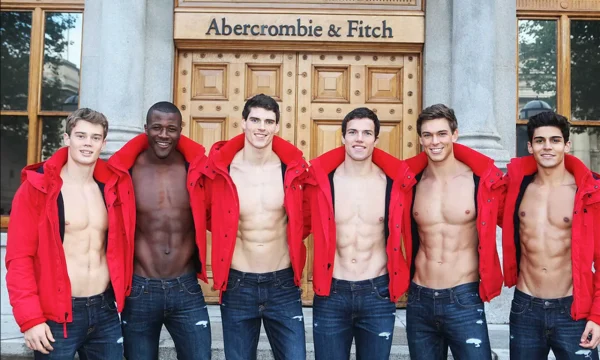Television Review: “White Hot –The Rise and Fall of Abercrombie & Fitch”
By Sarah Osman
White Hot is a compelling watch, and not only for those who shopped at Abercrombie & Fitch.

A scene from Netflix’s White Hot –The Rise and Fall of Abercrombie & Fitch
Interestingly, Abercrombie & Fitch wasn’t always known as the dimly lit store covered with posters of half-clothed male models. When it first opened in 1892, Abercrombie Co. sold outdoorsy stuff to outdoorsy men (it was essentially an upscale version of REI.) It wasn’t until 1988, when the company was bought by Limited Brands, that Abercrombie & Fitch transformed into the place where all the cool kids purchased their preppy clothes.
This is one of the interesting, albeit less juicy, tidbits revealed in the documentary White Hot: The Rise and Fall of Abercrombie & Fitch. Directed by Alison Klayman, who helmed the documentary Jagged, which focused on Alanis Morissette, White Hot rubs off layers of gloss to expose the good, the bad, and the ugly of the famed brand. And she has an effective strategy for encapsulating the madness that was Abercrombie & Fitch: combine upbeat pop from the ’90s and early 2000s with disturbing interviews.
When Abercrombie & Fitch was first acquired in the late ’80s, Les Wexner, an expert on retail and later an accomplice of Jeffrey Epstein’s, brought on CEO Mike Jeffries to rebrand. And did he ever rebrand — Jeffries was the mastermind behind the store’s dark aesthetic, loud music, and erotic photos. The infamous photos were taken by photographer Bruce Weber who, as described by former models, was quite the pervert. Jeffries was also hands-on: he loved to micromanage and, while his micromanaging did turn a profit, it also led to significant problems.
It’s no secret that Abrecrombie & Fitch had a diversity problem. There was a chief diversity officer, but the company relied on what it called an “All-American, clean cut” look, which translated into attractive WASPs. Multiple employees of color discuss the discrimination they faced, such as not being allowed to work on sales floors of the stores. They were regulated to the stockroom and then let go without any discernible reason. A trio of employees even sued the company for discrimination. They were paid a settlement, but little changed at the company. Jeffries says in an interview that he wanted the brand to appeal to the “all-American cool kid,” which apparently meant that stereotypical and offensive T-shirts regarding Asian-Americans could be sold.
While quite a few consumers have been aware of Abercrombie & Fitch’s shocking behavior, White Hot is still a jarring watch. It’s a reminder (and dissection) of just how oversexualized media became in the early 2000s. While the series focuses on the company’s blatant racism, it doesn’t delve very deeply into its discrimination against different types of bodies. In order to get hired at Abercrombie & Fitch, potential employees were ranked on an “attraction scale,” which is why so many were white: white was considered the most desirable. However, this scale also picked store “models” that were skinny, hence enforcing the idea that skinny is gold. No curvy models were ever selected to work there, and it’s a little disappointing that the film doesn’t delve into this destructive part of the company’s culture.
One of the most interesting interviews is with the chief diversity officer, a Black man named Todd Corley. It’s clear that he did try his best to alter the company’s all-white culture, but he obviously wasn’t successful. Corley’s struggles reflect a political dilemma: just how reasonable is it to assume that one person of color can effect change in an entirely white company. For example, when the racist T-shirts are discussed, some point out that, even if there were Asian-Americans on staff, their feedback would most likely have been ignored — if they had the courage to speak out at all, given fears of being fired. As more and more companies claim that they are devoted to diversity, White Hot undercuts our sense that things will become better. Are companies actually hiring people of color and putting them in leadership positions? Or are they just hiring a token to make charges of systemic racism go away?
For those familiar with, or who grew up with, Abercrombie & Fitch, White Hot is a compelling watch. The company is trying to rebrand itself (yet again), but it’s an uphill battle given its problematic history, especially when its sins are laid out in such a clear-cut and straightforward fashion. Thankfully, the film never tries to sensationalize the company’s past. Viewers can decide for themselves how far and how bad the fall was. White Hot joins a growing list of documentaries that delve into the dark side of American retail, more proof that clothes do not make the company.
Sarah Mina Osman is a writer residing in Wilmington, NC. In addition to writing for the Arts Fuse, she has written for Watercooler HQ, Huffington Post, HelloGiggles, Young Hollywood, and Matador Network, among other sites. Her work was included in the anthology Fury: Women’s Lived Experiences in the Trump Era. She is currently a first year fiction MFA candidate at the University of North Carolina Wilmington. When she’s not writing, she’s dancing, watching movies, traveling, or eating. She has a deep appreciation for sloths and tacos. You can keep up with her on Twitter and Instagram: @SarahMinaOsman
